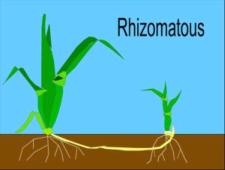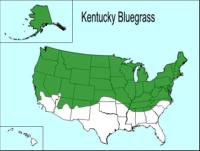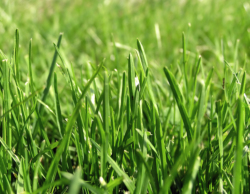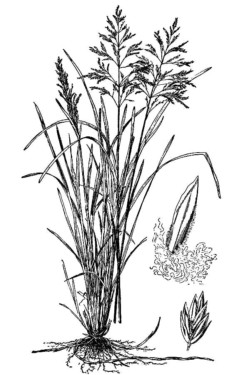Kentucky bluegrass is the most popular cool-season grass for northern climates. It is used in home lawns, parks, athletic fields and golf courses. Bluegrasses require medium amounts of lawn care. With proper management, this species will form a dense, dark green, attractive lawn.
Over 100 cultivars (cultivated varieties) have been developed that differ in color, texture, density, vigor, disease resistance and tolerance to close mowing. It can be found throughout North America in temperate to subarctic climates and at high altitudes in tropical and subtropical climates. It is not common in the Gulf States or the desert regions of the Southwest.
This lawn grass is winter hardy and well-adapted to a wide range of environmental conditions but prefers moist, well-drained, fertile soils with a pH of 6 to 8 and grows best in full sun but will tolerate light shade. Lawn irrigation is necessary during hot, dry periods or it tends to become dormant and lose color – turning brown.
A key feature of Kentucky bluegrass is its sod-forming ability. It spreads by underground lateral stems called rhizomes. This strong rhizomatous nature of Kentucky bluegrass allows it to rapidly recuperate from injury and fill thin areas in your lawn and makes it a valued turfgrass for golf course fairways and sports fields.
Characteristics of Kentucky Bluegrass
- Cool-season perennial
- Reproduces through tillers, rhizomes and seeds
- Medium to fine texture
- Medium to dark green color
- Good sod-forming abilities (rhizomatous)
- Optimum growth in the Spring and Fall
- Winter hardy
- Rapidly recuperates from injury
- Mows cleanly
- Shallow rooted
- Best in full sun to light shade
- well-drained, moist, fertile soils
- medium to high inputs of water and fertilizers
Identification
- The leaf blades have a boat-shaped tip
- Parallel light lines on either side of the central vein
- The new leaves are folded in the bud
- Very short, membranous ligule
- No auricles
Mowing
Kentucky bluegrass mowing height is between 2 to 3.5 inches.
For optimum performance, mow relatively high, especially during the warm months. This turfgrass is very competitive against weed invasion when maintained in the 2.5 to 3.5″ range. Mowing higher in shady lawns will help counter its shade intolerance by giving it more leaf area to catch the light.
Watering
Water your lawn to supplement rainfall, encourage deep rooting, and sustain a healthy growth rate.
Because Kentucky bluegrass has a shallow root system, it requires 1 to 1.5 inches of water in the spring and 1.5 to 2 inches per week in the summer.
Fertilizing
Fertilize using 3 – 5 lbs. nitrogen/1000 sq. ft. per year.
- 5 lbs. per year for high-maintenance lawns and where clippings are collected.
- 3 lbs per year for moderately maintained lawns.
Apply 1 to 2 pounds of nitrogen fertilizer in the spring and 2 to 3 pounds of nitrogen in the fall. Slow-release fertilizers are recommended.
Timing and rate (nitrogen per 1000 sq. ft.):
- Late April to early May – 1 lb slow-release nitrogen
- June to early July – 1/2 to 1 lb slow release nitrogen
- September – 1 to 1 1/2 lbs nitrogen
- November – 1 to 1/2 lbs nitrogen




Planting New Kentucky Bluegrass Lawns
New lawns can be established by seeding or sodding. The best time of year to plant Kentucky bluegrass is late August through September.
Sod is readily available from sod growers throughout the United States.
Seeding
Seed at a rate of 2 – 3 lbs seed/1000 sq. ft.
Establishment from seed can be slow, with 10-20 days for germination. It is recommended to seed a blend with 15% perennial ryegrass.
Bags of seed are usually sold as blends. Seed blends result in lawns with improved appearance, resistance to disease and insects and adaptability to environmental conditions.
Bluegrasses mix well with companion cool-season grasses – perennial ryegrass and fine fescues – producing a better multi-purpose lawn. Perennial ryegrass seed will tolerate heavy shade and its seeds germinate quickly making it a nurse grass that protects slower germinating species. Fine fescues are shade very drought tolerant making them ideal for areas under trees and drier patches in your lawn.
Pests and Problems
Weeds, insects and disease problems are telling you that your lawn is out of balance. A healthy, vigorously growing bluegrass lawn usually can tolerate normal levels of insect and disease activity. Selecting cultivars that are resistant and sound watering, mowing and fertilizing practices are the best ways to prevent and reduce pest damage.
Weeds
Annual bluegrass, crabgrass, dandelions and clover are the most common weed problems.
Insects
Common insect pests include white grubs, billbugs and sod webworms.
Diseases
Kentucky bluegrass has a tendency to develop powdery mildew when planted in shady areas. Other common fungal diseases include leaf spot, dollar spot, summer patch, snow mold, rust and necrotic ring spot.
Thatch
Spreading growth habit makes Kentucky bluegrass susceptible to thatch development especially under high fertility and moist conditions.
Proper lawn care practices will keep thatch from becoming a problem.
More Grass Types:
Buffalo Grass Lawns Buchloe dactyloides
A warm-season perennial grass that is a good choice for low-maintenance landscapes. Buffalo grass is the only native grass species widely used in lawns.
Bermuda Grass Lawn Care, Types, Planting and Maintenance
What is Bermuda grass? Hybrid vs. Common uses and the best types for home lawns. How to plant and care for a Bermudagrass lawn. Helpful DIY tips and advice for planting and growing grass.
Zoysia Grass
Is Zoysia grass perfect for home lawns? It’s beautiful when properly maintained. If you are lucky enough to live in a climate suitable for growing warm-season grasses, zoysia might be the best choice.
